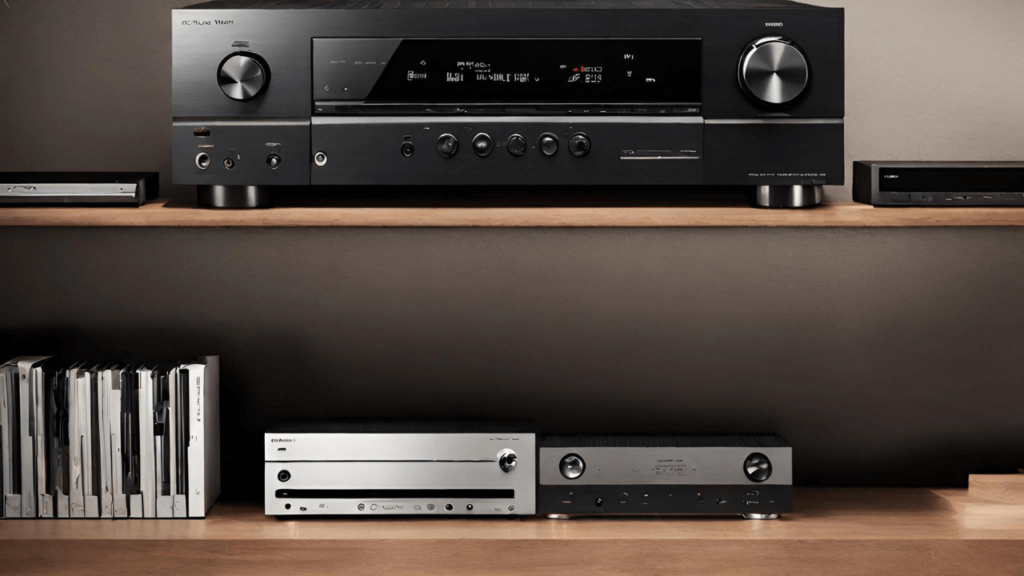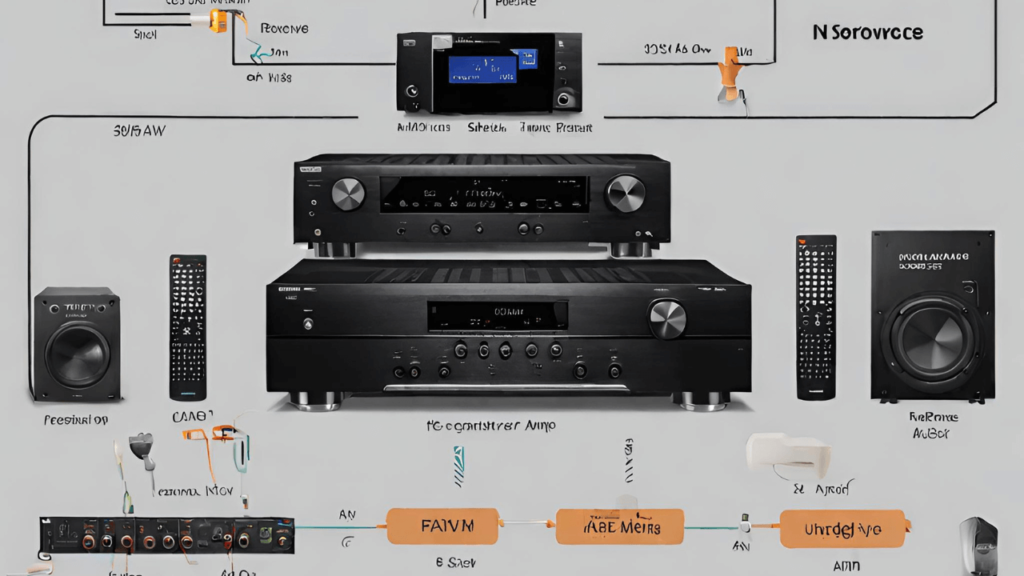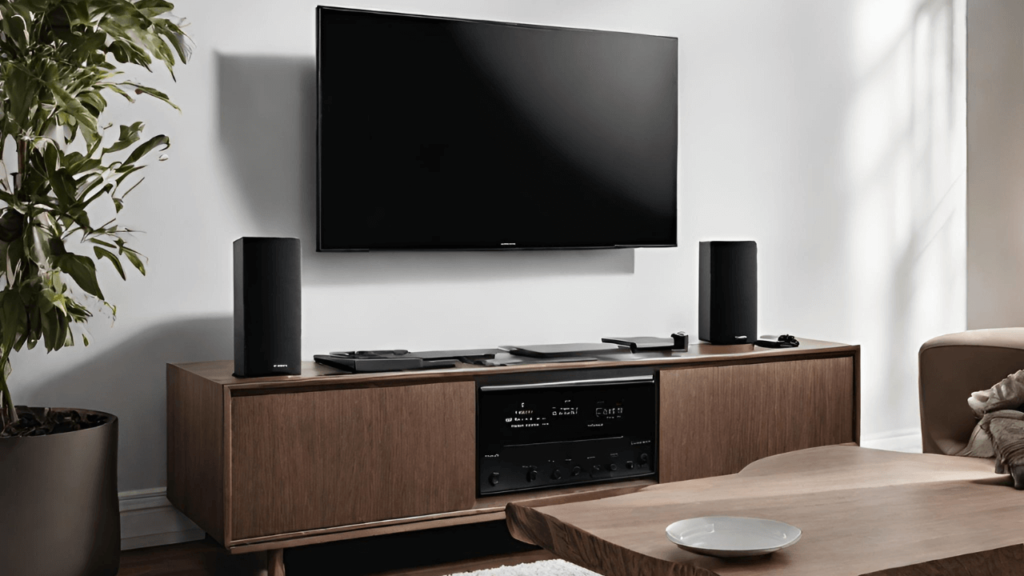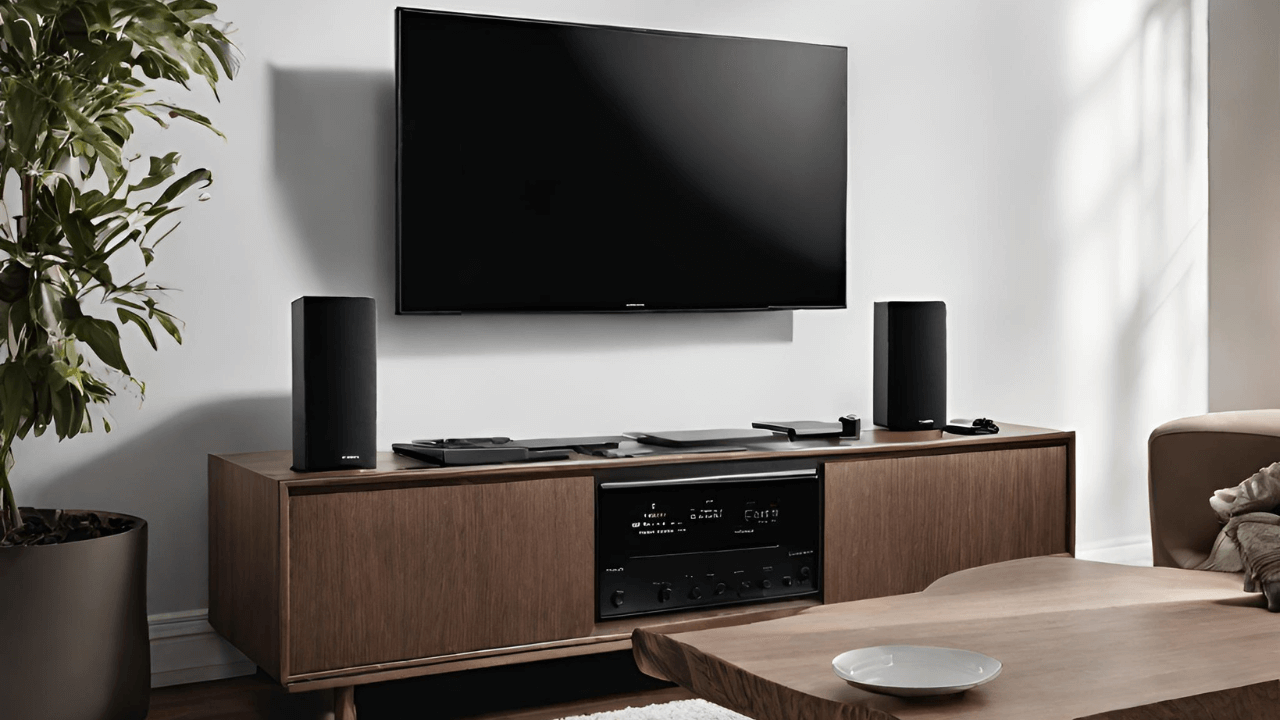What is an AV receiver? Best AV Receiver Under $500

What is an AV Receiver?
An AV receiver, short for an Audio-Video receiver, is a key component of a home theater or audio system. It serves as the central hub for connecting and managing various audio and video sources, such as Blu-ray players, gaming consoles, cable/satellite boxes, streaming devices, and speakers. AV receivers are typically used in home entertainment setups to provide high-quality audio and video playback, as well as the ability to control and customize the audio and video settings.
Here are some of the main functions and features of an AV receiver:
- Audio Amplification: AV receivers have built-in amplifiers that power the speakers in your home theater system. They can support various speaker configurations, from stereo setups to multi-channel surround sound systems.
- Video Switching: AV receivers often come equipped with multiple HDMI inputs and outputs, allowing you to connect different video sources (e.g., game consoles, Blu-ray players, cable boxes) to a single device. This simplifies the process of switching between video sources using a single remote control or on-screen menu.
- Audio Processing: AV receivers can decode various audio formats, such as Dolby Digital, DTS, and more advanced formats like Dolby Atmos and DTS:X. This enables immersive surround sound experiences with multi-channel speaker setups.
- Room Calibration: Many modern AV receivers feature room calibration technologies like Audyssey, YPAO (Yamaha Parametric Acoustic Optimizer), or MCACC (Multi-Channel Acoustic Calibration System). These systems analyze the acoustics of your room and adjust the audio settings to optimize sound quality.
- Networking and Streaming: Some AV receivers are equipped with network connectivity, allowing you to stream music and videos from online services like Spotify, Pandora, or Netflix. They may also support wireless technologies like Bluetooth and Wi-Fi for connecting to your mobile devices or a home network.
- Zone Outputs: High-end AV receivers often offer multiple zones, allowing you to send audio and video signals to different rooms or areas of your home. This is useful for creating a multi-room audio system.
- Control and Integration: AV receivers can be controlled through a remote control, a smartphone app, or even integrated into a broader home automation system. This makes it easier to manage your home theater and audio setup.
In summary, an AV receiver is a versatile and central component in a home entertainment system, responsible for audio amplification, video switching, multi channel home theater, and various audio processing functions. It plays a crucial role in creating an immersive and high-quality audio-visual experience in your home theater or audio setup.

How to connect power amp to AV receiver
Connecting a power amplifier to an AV receiver can be done to enhance the audio output, especially if you have high-quality speakers or need more power for a larger room. Here are the general steps to connect a power amplifier to an AV receiver:
Materials You’ll Need:
- AV Receiver
- Power Amplifier
- RCA Interconnect Cables (usually one for each channel)
- Speaker Cables
- Speaker Wire
- Banana Plugs (optional, for speaker wire termination)
Steps:
- Power Off Everything: Before connecting any cables, make sure both your AV receiver and power amplifier are powered off and unplugged from the electrical outlet.
- Identify the Pre-Out and Main-In Terminals: On your AV receiver, look for the pre-out terminals. These are typically RCA outputs labeled as “Pre-Out” or “Preamp Out.” On your power amplifier, look for the corresponding main-in terminals, which are RCA inputs labeled as “Main-In” or “Power Amp In.” You’ll connect the pre-out of the receiver to the main-in of the amplifier.
- Connect RCA Interconnect Cables:
a. Take one RCA interconnect cable and connect one end to the pre-out of the AV receiver.
b. Connect the other end of the RCA cable to the corresponding main-in input of the power amplifier.
c. Repeat this process for each channel you want to connect (typically left and right channels). - Connect Speaker Cables:
a. Connect your speaker cables to the speaker outputs on the power amplifier. These outputs are usually labeled as “Speaker Out” or “Output.”
b. Connect the other end of the speaker cables to your speakers. Make sure to connect them to the corresponding left and right channels on the power amplifier. - Connect the Power Cables:
a. Plug in and turn on your power amplifier.
b. Ensure that the power amplifier is set to an appropriate input source or mode. - Configure the AV Receiver:
a. Turn on your AV receiver and access its settings menu.
b. Navigate to the audio setup or speaker configuration section.
c. Set the AV receiver to use the external power amplifier. This might involve configuring the receiver’s “Speaker Configuration” or “Pre-Out/Main-In” settings.
d. Perform any necessary calibration or setup adjustments for your specific AV receiver model. - Test the System: Play some audio or video content through your AV receiver, and verify that the sound is coming through the external power amplifier and your speakers correctly.
- Fine-Tune Settings: Adjust the volume levels, balance, and any other audio settings on both the AV receiver and power amplifier to achieve the desired audio performance.
By following these steps, you can successfully connect a power amplifier to your AV receiver, improving your audio setup’s overall performance and power output. Ensure that you consult the user manuals for your specific AV receiver and power amplifier for any model-specific instructions or considerations.

Best AV Receiver Under $500
As of my last knowledge update in September 2021, I can provide you with some popular AV receivers under $500. However, please note that product availability and pricing can change over time, so I recommend checking current prices and reviews before making a purchase. Here are a few AV receivers that were well-regarded in this price range:
- Denon AVR-S750H: This 7.2-channel AV receiver offers excellent audio quality, support for 4K Ultra HD, Dolby Atmos, DTS:X, and HEOS wireless multi-room audio. It also has built-in Bluetooth and Wi-Fi for streaming.
- Yamaha RX-V485: Yamaha’s RX-V series has been known for its quality, and the RX-V485 is no exception. It supports 5.1-channel audio, 4K Ultra HD, and has Yamaha’s Cinema DSP 3D for immersive sound.
- Sony STR-DH790: Sony’s STR-DH series is known for its affordability and good performance. The STR-DH790 supports 7.2-channel audio, 4K Ultra HD, and has Bluetooth connectivity for easy streaming.
- Onkyo TX-SR393: Onkyo offers a range of budget-friendly AV receivers, and the TX-SR393 is one of them. It supports 5.2-channel audio, 4K Ultra HD, and has Bluetooth connectivity.
- Pioneer VSX-LX303: Pioneer’s VSX-LX303 is a 9.2-channel receiver that provides excellent audio quality and supports various audio formats, including Dolby Atmos and DTS:X. It also has Chromecast built-in and works with Amazon Alexa.
- Marantz NR1510: Marantz is known for its high-quality audio, and the NR1510 is a slimline 5.2-channel receiver that supports 4K Ultra HD, Dolby Atmos, and DTS:X. It has built-in Wi-Fi and Bluetooth for streaming.
Remember that when choosing an AV receiver, consider your specific needs, such as the number of channels you require, the compatibility with your speakers, the connectivity options you need, and any additional features like room calibration. Also, check for any updates or newer models that may have been released since my last update. Reading user reviews and professional evaluations can also help you make an informed decision based on your preferences.
See Some Best AV Receiver From Amazon:
Some Bad Side Of AV Receiver
While AV receivers offer many advantages for audio and video enthusiasts, they also have some potential drawbacks and limitations. Here are some of the common downsides or challenges associated with AV receivers:
- Cost: High-quality AV receivers with advanced features can be expensive. While there are budget-friendly options available, premium models with cutting-edge technology can be quite costly.
- Complexity: AV receivers often come with a multitude of settings and options. This complexity can be overwhelming for users who are not familiar with audio and video terminology or who prefer a simpler setup.
- Setup and Calibration: Setting up an AV receiver can be a time-consuming process, especially if you’re integrating multiple speakers, sources, and calibration tools. Room calibration, while beneficial, can also be challenging for beginners.
- Size and Space: AV receivers are typically large and bulky components. Finding a suitable place to house them in your entertainment center can be a challenge, especially if you have limited space.
- Power Consumption: AV receivers can consume a significant amount of electricity, particularly when they are in standby mode. This can contribute to higher energy bills over time.
- Heat Generation: AV receivers generate heat during operation. Proper ventilation and heat management are essential to prevent overheating, which can lead to component damage.
- Obsolete Technology: As technology evolves rapidly, AV receivers can become outdated relatively quickly. Newer audio and video formats may not be supported by older models, necessitating an upgrade.
- Compatibility Issues: Some AV receivers may have compatibility issues with certain devices or HDMI protocols. This can result in frustrating connectivity problems or the need for firmware updates.
- Remote Control Complexity: AV receiver remote controls can be complex, with numerous buttons and functions. Learning to navigate and use the remote effectively can be challenging for some users.
- Limited Audio Inputs: Entry-level AV receivers may have a limited number of audio inputs. If you have many audio sources, you may need to invest in additional equipment, such as an external switcher.
- Speaker Matching: Matching your AV receiver to the right speakers is crucial for optimal performance. Mismatched components can result in subpar audio quality.
- Lack of Future-Proofing: As technology advances, older AV receivers may not support the latest audio and video formats or features. This can lead to the need for frequent upgrades.
Despite these drawbacks, many people find that the benefits of AV receivers, such as improved audio quality, centralizing audio and video sources, and support for various formats, outweigh these disadvantages. Careful research, proper setup, and regular maintenance can help mitigate some of the challenges associated with AV receivers.
Why You Can’t Avoid An AV Receiver?
While an AV (Audio-Visual) receiver is a valuable and versatile component in many home theater and audio setups, it’s important to note that it’s not always an absolute necessity, and there are scenarios in which you might choose not to use one. Here are some situations where you might consider bypassing an AV receiver:
- Simple Stereo Setup: If you have a basic stereo audio setup with just two speakers and no need for surround sound or multiple audio sources, you can connect your audio sources directly to your stereo speakers without the need for an AV receiver.
- Soundbar or Powered Speakers: Soundbars and powered speakers (speakers with built-in amplification) are designed to work without an AV receiver. These systems are often used in smaller spaces or for simplified audio setups.
- Built-in Amplification: Some TVs come with built-in amplification and multiple audio inputs, allowing you to connect external devices directly to the TV. In such cases, the TV functions as both the display and the audio hub.
- Budget Constraints: If you’re on a tight budget or have limited space, you might choose to forgo an AV receiver and use a simpler, more cost-effective audio solution.
- Specific Use Cases: In certain specialized setups, such as computer audio setups or small office setups, you may not require the features and capabilities of an AV receiver.
- Wireless Audio Systems: Some wireless audio systems, like Sonos or Bose SoundTouch, have their own control hubs that can handle audio distribution and control without the need for a traditional AV receiver.
- Soundbar with HDMI Switching: High-end soundbars with HDMI switching capabilities can serve as a hub for multiple HDMI sources, effectively replacing the need for an AV receiver in simpler setups.
- Streaming Audio Devices: Many streaming audio devices, such as smart speakers or wireless adapters, can directly connect to your speakers or audio system without the intermediary of an AV receiver.
While AV receivers offer numerous advantages, including advanced audio processing, support for multiple audio and video sources, and room calibration features, they are not always required or the most practical choice for every audio setup. The decision to use or avoid an AV receiver depends on your specific needs, preferences, and the complexity of your audio and video setup.
See Some Best AV Receiver From Amazon:
FAQ For AV Receiver
Certainly, here are some frequently asked questions (FAQs) and answers about AV receivers:
1. What is an AV receiver?
- An AV (Audio-Visual) receiver is a central component of a home theater or audio system. It acts as a hub for connecting audio and video sources (e.g., Blu-ray players, game consoles, speakers) and amplifies audio signals to deliver sound to your speakers.
2. What are the main features to consider when choosing an AV receiver?
- Key features to consider include the number of channels (e.g., 5.1, 7.2), compatibility with audio and video formats (e.g., Dolby Atmos, 4K Ultra HD), connectivity options (e.g., HDMI, Bluetooth), and room calibration capabilities.
3. How do I connect speakers to an AV receiver?
- You typically connect speakers to an AV receiver using speaker wires or cables. Match the positive and negative terminals on the receiver to those on the speakers, ensuring proper polarity. You may also use banana plugs or bare wire connections.
4. What is the purpose of HDMI ports on an AV receiver?
- HDMI ports on an AV receiver allow you to connect HDMI sources (e.g., Blu-ray players, gaming consoles) to the receiver, which then sends both audio and video signals to your TV or projector. This simplifies connectivity and provides high-quality audio and video.
5. How do I set up room calibration on an AV receiver?
- Room calibration, such as Audyssey or YPAO, can optimize audio performance for your specific room. Typically, you place a microphone in various listening positions, and the receiver emits test tones to analyze the room’s acoustics and adjust audio settings accordingly.
6. Can I use an AV receiver without an external amplifier?
- Yes, most AV receivers have built-in amplifiers, allowing you to power speakers directly. However, some AV receivers offer preamp outputs, enabling you to connect external power amplifiers for more demanding setups.
7. Do I need to update my AV receiver’s firmware?
- It’s a good practice to check for firmware updates periodically. Manufacturers release updates to fix bugs, improve performance, and add new features. Updates are often available for download from the manufacturer’s website and can be installed via USB or network.
8. How can I control my AV receiver remotely?
- AV receivers usually come with a remote control. Some also support smartphone apps or compatibility with universal remote controls. Additionally, many AV receivers can be controlled via voice commands with smart speakers like Amazon Alexa or Google Assistant.
9. What’s the difference between stereo, 5.1, 7.1, and 9.2 channel AV receivers?
- The numbers represent the channels of audio output. For example, a 5.1-channel AV receiver supports five main speakers and a subwoofer. More channels allow for more immersive surround sound experiences, such as Dolby Atmos.
10. Can I connect a turntable to an AV receiver?
– Yes, many AV receivers have a dedicated “phono” input for turntables. If your receiver doesn’t have this input, you can use an external phono preamp to connect the turntable to one of the regular audio inputs.
Remember that the specific features and functions of AV receivers can vary by brand and model, so it’s important to consult the user manual for your particular receiver for detailed setup and operation instructions.

